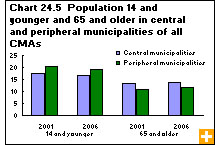Common menu bar links
Spreading suburbs
Archived Content
Information identified as archived is provided for reference, research or recordkeeping purposes. It is not subject to the Government of Canada Web Standards and has not been altered or updated since it was archived. Please contact us to request a format other than those available.
The increasingly urbanized Canadian population has meant urban spread: more rapid growth around the edges than in the centre of census metropolitan areas (CMAs). Urban population spread poses many challenges, notably transportation, deliveryof services and environmental issues.
From 2001 to 2006, the growth of peripheral municipalities surrounding Canada’s 33 CMAs was 11%, or double the national average of 5%. Growth in the central municipalities was slower, at 4%.
Urban population spread usually occurs along major transportation routes. For example, in the Toronto CMA, peripheral municipalities have developed along a network of expressways.
Around Montréal, municipalities like Saint-Jérôme, north of Montréal, and Boucherville on the SouthShore have all experienced rapid growth as a result of the developing transportation infrastructure.
In 2006, almost 20% of the population in the suburbs was under the age of 15, compared with 17% in central municipalities. The suburbs also account for a greater population of residents aged 40 to 59, many of whom likely live among families with children.
The population of 20- to 34-year-olds is higher in the CMAs of Toronto, Montréal and Vancouver than in the suburbs. This might stem from an influx of young migrants from other parts of the country and large numbers of immigrants.
The proportion of seniors is higher in central municipalities than in the suburbs: 14% com-pared with 12%. In Toronto, Montréal and Vancouver, the higher proportion of seniors may be linked to the presence of seniors’ residences and health services intended to meet the needs of the senior population.



